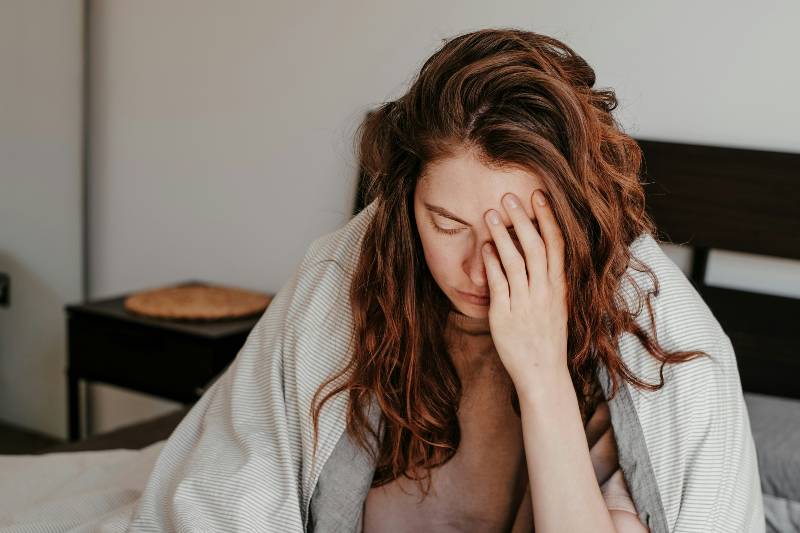If you find yourself with a headache after taking a nap, you’re not alone. Many people have this problem, and usually, there’s a simple or complex reason for it.
Let’s see what the reason makes you have a headache after a nap, and how to manage it.
1. Sleep Position
The way you position yourself while napping can significantly influence whether you wake up feeling great or groggy with a pounding headache.
If your neck or head is angled awkwardly, you could be putting undue pressure on your muscles and blood vessels. This tension can lead to headaches.
To avoid this, ensure your sleeping environment supports a natural alignment of your head, neck, and spine. Use a pillow that maintains this alignment, avoiding positions that crick your neck or keep your head too high or too low.
An ideal sleeping posture facilitates healthy blood flow and minimizes muscle strain, reducing the likelihood of waking up with a headache.
2. Teeth Grinding
Teeth grinding, or bruxism, is a common yet often overlooked cause of headaches after napping.
It can occur during both day and night but might go unnoticed during sleep. Grinding your teeth exerts excessive force on your jaw muscles and can lead to tension headaches.
If you often wake up from naps with a headache and sore jaw or face, it’s worth considering whether teeth grinding could be the culprit.
Managing stress and avoiding caffeine or alcohol before naps can help, but it might also be beneficial to speak with a dentist. They can suggest wearing a mouth guard while sleeping, which can prevent grinding and, by extension, the headaches that follow.
3. Dehydration
Dehydration is a sneaky headache trigger. Even mild dehydration can lead to a headache after waking up from a nap.
When you’re asleep, you’re not drinking water, so if you enter a nap slightly dehydrated, you might wake up feeling the effects.
Before settling down for a nap, drink a glass of water, especially if you’re prone to headaches. Keeping hydrated throughout the day is crucial, but ensuring you’re not dehydrated before a nap can make all the difference.
4. Caffeine or Alcohol
Both caffeine and alcohol can influence your sleep quality and headache vulnerability. Consuming caffeine too close to naptime or drinking too much can disrupt your sleep cycles, making it harder to fall asleep or causing you to wake up feeling unrested and possibly with a headache.
Caffeine withdrawal can also cause headaches, so if you’re used to regular doses throughout the day, skipping your usual coffee or tea before a nap may inadvertently trigger a headache.
On the other hand, even though alcohol might make you feel sleepy, it lowers the quality of your sleep. It prevents you from reaching the deep, restorative stages of sleep, leading to a feeling of unrest and potentially causing headaches.
To minimize the risk, it’s best to avoid alcohol and moderate caffeine intake, especially in the hours leading up to your nap.
5. Poor Sleep Hygiene
Poor sleep hygiene encompasses a variety of habits and environmental factors that prevent effective sleep. It’s not just about the night; poor practices can equally affect your naps.
This includes irregular napping times that confuse your body’s internal clock, a sleep environment that’s too bright or noisy, and the use of electronics right before napping which can engage your brain too much, making it harder to fall asleep.
A messy or uncomfortable place to sleep can cause headaches or or even make them worse.
Creating a pre-nap routine can help signal to your body that it’s time to rest, allowing you to fall asleep more quickly and deeply. This might involve dimming the lights, reading a book, or practicing a few minutes of meditation to relax your mind.
Ensuring your napping space is quiet, dark, and at a comfortable temperature can also improve your sleep quality, making headaches less likely when you wake up.
6. Sleeping Too Much or Too Little
The duration of your nap also plays an important role in how you feel afterward. Sleeping for too long, especially during the day, can disrupt your nighttime sleep patterns, leading to sleep deprivation—ironically, this can result in headaches.
On the flip side, short, inconsistent naps might not provide sufficient rest, leaving your body stressed and primed for a headache.
The ideal nap length for most people is around 20-30 minutes. This timeframe allows your body to rest without entering deep sleep phases that can make you groggier and more prone to headaches upon waking.
Setting an alarm can help you keep your naps within this sweet spot, which ensures you wake up refreshed rather than with a headache.
7. Muscle Tension
Muscle tension in your neck and shoulders can also contribute to headaches after napping. This tension can be due to poor posture during the day, whether from sitting at a desk, driving, or even standing with poor alignment.
When you finally take a nap, your body is in a state of stress and tension, which doesn’t always disappear just because you’re resting. Your muscles might remain tight, especially if your nap environment doesn’t support a proper, relaxed posture.
To alleviate the risk of muscle tension causing a headache, focus on improving your posture during your waking hours. Stretch regularly, especially if you have a sedentary lifestyle, and consider doing relaxation exercises before your nap to loosen up any tightness in your muscles.
Moreover, setting up a comfortable nap space where your head, neck, and back are properly supported can prevent additional strain on your muscles during the nap.
8. Sleep Inertia
Sleep inertia refers to the groggy, disoriented feeling you might experience upon waking up from a nap, especially if the nap was longer than intended.
This occurs because long naps can plunge you into deep sleep, making it harder for your brain to reorient itself upon waking. This disorientation can manifest as a headache, clouding your post-nap period with discomfort instead of rejuvenation.
To combat sleep inertia, stick to the recommended 20-30 minute nap length to avoid entering deep sleep. If you find yourself frequently experiencing sleep inertia with accompanying headaches, consider using a sleep cycle alarm that wakes you up at the best time of your nap to minimize grogginess and discomfort.
Additionally, giving yourself a buffer of time to wake up gradually—instead of jumping straight into activities—can help your body adjust, reducing the chances of a headache. Engaging in light activities such as stretching or a short walk can also help shake off the grogginess more effectively.
9. Sleep Apnea & Snoring
Obstructive sleep apnea (OSA) is a condition characterized by pauses in breathing during sleep due to airway blockage. Snoring, a common symptom of OSA, can also be an independent factor for sleep disruption.
Both conditions can severely impact the quality of your sleep, leading to fragmented and unrefreshing naps that could result in headaches.
If you suspect sleep apnea or have been told that you snore loudly, it’s essential to consult a healthcare provider.
Treatment options such as CPAP (Continuous Positive Airway Pressure) devices can vastly improve your sleep quality, lessening the likelihood of waking up with a headache. A conducive sleep environment and a side-sleeping position can also reduce snoring and improve your sleep quality.
10. Migraine
For individuals prone to migraines, napping can sometimes trigger an attack, resulting in severe headaches. Migraines can be influenced by disruptions to your sleep pattern, including both insufficient sleep and excessive sleep.
Therefore, while napping might seem like a good way to catch up on rest, it can inadvertently lead to a migraine episode for some people.
To manage this, establishing a consistent sleeping schedule is key, even when it comes to naps. Try to nap at the same time every day if you need to and avoid napping too late in the day as it can interfere with your nighttime sleep.
For migraine sufferers, it’s also crucial to be mindful of other potential triggers that might coincide with your nap time, such as skipping meals or dehydration. Take your nap in a comfortable, migraine-friendly environment—quiet, dark, and cool—can also help mitigate the risk.
11. Other Health Conditions
Beyond the direct causes already discussed, various other health conditions can lead to headaches after napping. Issues like hypertension (high blood pressure), low blood sugar, and certain types of infections can lead to headaches.
Not getting enough sleep or even sleeping too much can make these headaches worse.
It’s important to pay attention to any other symptoms you might be experiencing alongside your headaches, as they could point to a broader health issue that needs addressing.
If you find that your post-nap headaches are persistent and not relieved by addressing the usual suspects like hydration, sleep position, and nap length, it might be wise to consult with a healthcare professional. They can assess whether an underlying condition might be contributing to your symptoms.
Regular headaches, especially if they’re severe or accompanied by other symptoms like vision changes, difficulty speaking, or muscle weakness, should always be evaluated by a professional.
In addition to seeking medical advice, maintaining a headache diary can be beneficial. Track when your headaches occur, their intensity, what you ate or drank beforehand, your sleep quality, and any other relevant factors.
This information can provide valuable insights into patterns or triggers specific to you, which can be useful for both you and your healthcare provider in managing or preventing headaches after naps.
Conclusion
It can be really annoying to get a headache after a nap, especially when all you wanted was to wake up feeling refreshed.
While several factors can contribute to post-nap headaches—from sleep position and dehydration to more complex issues like sleep apnea and underlying health conditions—the good news is that many of these triggers are manageable with proactive strategies.
Making sure you have a good place to sleep, keeping up with healthy sleep habits, and taking care of any health problems can greatly reduce the chances of waking up with a headache.
But if your headaches persist or you experience additional concerning symptoms, reaching out for medical advice is imperative.





